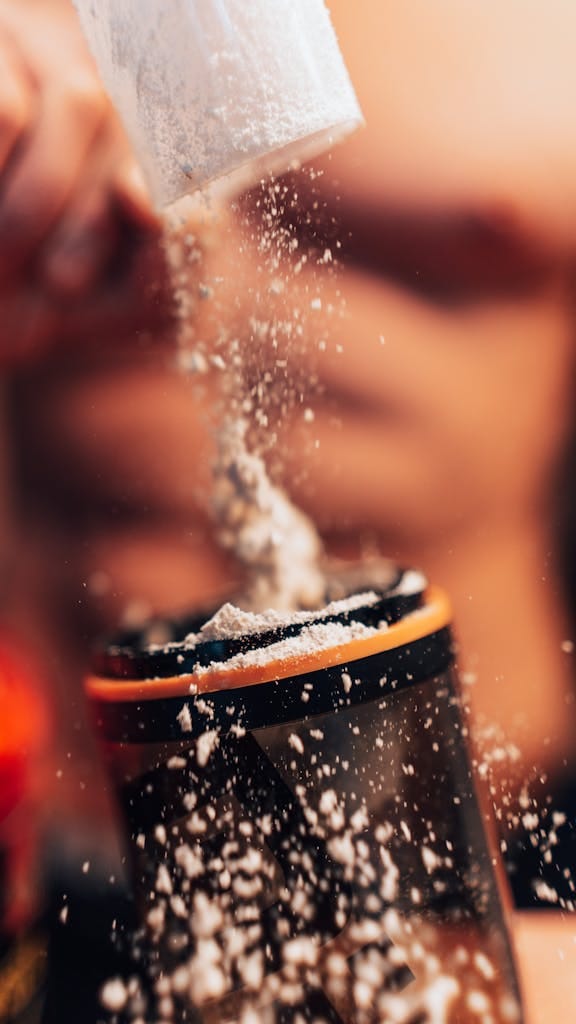FREE SHIPPING OVER $50
NEVER Mix These 5 Ingredients With Protein Powder—Dietitians Say It Could Backfire

You buy high-quality protein powder because you are serious about your fitness goals, maximizing muscle synthesis, and crushing that post-workout routine. But here is a critical truth: what you mix your protein powder with matters just as much as the powder itself. Many health-conscious people diligently try to pack their shakes with extra micronutrients and healthy add-ins, unaware that they are actively sabotaging their efforts. They are inadvertently creating concoctions that interfere with protein absorption, cause major gastrointestinal distress, or even reduce the protein’s biological value.
The goal of drinking a protein shake is typically speed and efficiency—you want that quick supply of amino acids delivered rapidly to your muscles, especially after a workout. However, dietitians consistently warn against five common mix-in mistakes that can cause your entire supplement strategy to backfire. If you have ever felt bloated, suffered cramping, or simply haven’t seen the muscle gains you expected, the culprit might not be your training—it could be your shake recipe. Read on to learn exactly what to avoid to maximize your supplement investment.
The Science Behind the ‘Backfire’: Why Absorption Matters
When a dietitian warns that a mix-in could “backfire,” they are usually referring to two things: a failure of absorption or the onset of severe digestive issues. For protein powder to be effective, it must travel through your digestive system quickly, where stomach acids break it down into amino acids for rapid delivery to the bloodstream.
Any ingredient that dramatically slows down this process, creates curdling, or causes unnecessary fermentation can derail the entire process. The protein either becomes less bioavailable, or your body spends so much energy fighting gastrointestinal distress that the benefits are negated. Avoiding these common supplement mistakes is the fastest way to ensure you are getting the optimal results from every scoop.
Ingredients You Should Never Mix With Protein Powder
1. Excessive High-Fiber Supplements
While fiber is essential for health and digestion, loading your post-workout shake with extra fiber supplements (like psyllium husk or large quantities of chia seeds) can be counterproductive to your fitness goals.
The Backfire: The immediate post-workout window requires fast-acting protein (like whey protein isolate) to kickstart muscle synthesis. Fiber, by its very nature, significantly slows down gastric emptying—the rate at which food leaves the stomach. When you mix a large dose of supplemental fiber with your protein, you essentially create a slow-moving, thick sludge in your stomach. This dramatically slows down the delivery of amino acids to your muscles, rendering your “fast-acting” protein anything but. For those relying on protein shakes for quick recovery, this delay defeats the purpose. Furthermore, excessive fiber, especially with limited fluids, is a leading cause of bloating, gas, and constipation.
Dietitian’s Takeaway: Focus on fast-digesting fluids for your post-workout shake. Save your high-fiber intake for solid meals later in the day when the timing of protein absorption is less critical.
2. Highly Acidic Juices
It might sound delicious to blend your vanilla protein with a vibrant glass of orange juice or pineapple juice, but this combination can quickly turn into a lumpy, unpleasant mess that is difficult to digest.
The Backfire: This is primarily an issue with dairy-based proteins, particularly whey protein, which is a milk derivative. Milk proteins are sensitive to highly acidic environments. When you introduce a powder to a low pH liquid like citrus juice, the protein structure can rapidly denature (or curdle) before it even hits your stomach. This process separates the protein solids from the liquid, creating a thick, grainy texture. While denatured protein is still digestible, the texture is often awful, and your body has to work harder to break down the resulting clumps, slowing digestion and potentially contributing to stomach discomfort.
Dietitian’s Takeaway: If you want a fruity flavor, stick to simple water or a non-dairy milk base and add a small amount of low-acid fruits (like berries or bananas). Save the citrus for a standalone drink.
3. Too Much Added Fat or Oils
Many people try to make their shake a comprehensive meal by adding large spoonfuls of nut butters, coconut oil, or heavy cream to bulk up the calories. While healthy fats are vital, incorporating too much fat into a post-workout shake is a classic mistake.
The Backfire: Just like fiber, fat is the macronutrient that takes the longest to digest. Adding excessive amounts of fat—say, three tablespoons of peanut butter or a significant pour of heavy oil—greatly slows the rate of gastric emptying. The slower the shake leaves the stomach, the slower the protein gets to the muscles. If your primary goal is muscle repair and growth immediately following resistance training, this delay defeats the purpose of choosing a protein powder in the first place. You are effectively shifting your quick recovery drink into a slow-digesting meal replacement, which is fine at other times, but detrimental to the anabolic window.
Dietitian’s Takeaway: Keep the fat content minimal for immediate post-workout recovery. If you must add fat for satiety or calories, stick to a small amount of liquid fat (like a teaspoon of flaxseed oil) or half a serving of nut butter, saving the higher-fat meals for later.
4. Excessive Artificial Sweeteners or Sugar Alcohols
If you are mixing an already sweetened protein powder with extra drops of artificial liquid sweeteners (like Sucralose or Stevia) or tossing in several servings of sugar alcohols (like Xylitol or Maltitol), you are setting yourself up for serious digestive trouble.
The Backfire: Although these sweeteners are non-caloric, they are notorious for triggering gastrointestinal distress in sensitive individuals. The body often struggles to fully digest sugar alcohols. When they reach the large intestine undigested, the gut bacteria feast on them, producing gas, which leads to painful bloating, cramping, and even osmotic diarrhea. This type of physical discomfort—the literal “backfire”—can make you associate your protein shake with suffering, undermining your commitment to your entire routine. The goal of a supplement is to support your body, not cause internal turmoil.
Dietitian’s Takeaway: Check the label of your powder first; many are already heavily sweetened. If you need a little boost, use a small amount of natural, easily digestible sweeteners like a few dates or half a banana. Be vigilant about avoiding double-dosing on non-nutritive sweeteners.
5. Boiling Hot Liquids
Mixing your scoop into a piping hot cup of coffee or soup might seem like a great way to meet your protein quota on a cold day, but extreme heat is an enemy of protein structure.
The Backfire: Protein molecules are delicate structures held together by weak chemical bonds. When exposed to boiling or near-boiling temperatures, they undergo denaturation. While cooking solid food (like an egg) also denatures protein, which aids digestion, rapid denaturation in a liquid causes the powder to clump aggressively and become gritty. More importantly, high heat can damage some of the protein’s more sensitive amino acids and reduce the powder’s overall effectiveness and biological value, which impacts the potential for muscle synthesis. Nobody wants to spend money on high-quality vitamins and supplements only to destroy their efficacy with high heat.
Dietitian’s Takeaway: If adding protein to coffee, let the coffee cool to a warm (not hot) temperature first. You can also mix the protein powder with a small amount of cold water into a slurry before adding it to your warm beverage, which provides a smoother result.
Mixing for Maximum Results: What to Mix Instead
To guarantee you avoid the “backfire” and achieve optimal results, you need to ensure your protein is delivered quickly and smoothly. Dietitians generally recommend keeping it simple, especially during the post-workout window.
Your Go-To Base:
- Water: The fastest for absorption and zero friction. If speed is your goal, water is the champion mixer.
- Unsweetened Almond or Coconut Milk: These provide a creamy texture without adding significant fat or sugar, keeping digestion smooth and fast.
- Low-Fat Dairy Milk (if tolerated): Milk adds extra protein and a small amount of simple carbohydrates, which can be beneficial for post-workout energy restoration.
Smart Add-Ins for Balance:
- Simple Carbohydrates: A small piece of fruit (like a handful of berries or a banana) provides glucose to replenish muscle glycogen stores, which is often crucial for recovery and doesn’t significantly impede the transit of the protein.
- Essential Electrolytes: A pinch of salt or a splash of an electrolyte beverage (without added sugar) can help with rehydration without slowing absorption.
Conclusion
By steering clear of these five common mixing errors and simplifying your shake preparation, you take control of your consistency and ensure that every scoop of protein powder is working for your health and fitness goals, not against them.
Related Articles
- Creatine Results: Do You Really Need to Take It Every Day? Experts Break It Down
- 9 Doctor-Recommended Supplements That Help You Look Younger—#4 Is a Game-Changer
- The Truth About Fish Oil and Blood Pressure—What Cardiologists Want You to Know
- The $0.50 Supplement That Builds Muscle, Slows Aging & May Protect Your Brain from Alzheimer’s—Backed by Scientists
- Collagen Isn’t Just for Skin—Here’s How It Targets Belly Fat and Weight Gain After 50



